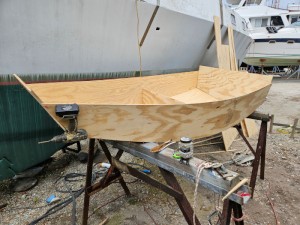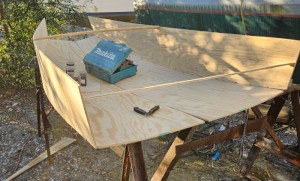Kaimusailing
s/v Kaimu Wharram Catamaran
| Vessel Name: | Kaimu |
| Vessel Make/Model: | Wharram Custom |
| Hailing Port: | Norwalk, CT |
| Crew: | Andy and the Kaimu Crew |
| About: | Sailors in the Baltimore, Annapolis, DC area. |
07 April 2024 | St. Marys, GA
Clammy Hands
Items came in from TEMU, the Chinese cut rate retailer. One was a nice little drone that cost about twelve and a half dollars. It looked like an easy thing to play with while I coughed and sneezed. I was fighting a summer cold, even though it is not summer elsewhere, it seems like it here. A nice [...]
02 April 2024 | St. Marys, GA
Sun Doggie
After laminating the cedar strips onto the gunwales of the dinghy I found the screws I used wouldn’t come out. The epoxy had seized them. The screw heads were stripped so I cut a straight slot in the heads with the cut off wheel. The cedar smoked when the screw heads got red hot. I could remove [...]
21 March 2024 | St. Marys, GA
Just Add Water
The rainy weekend started off with overcast and fog but no rain. It looked like I might be able to get something done on the D4 dinghy. I wanted to change the bow seat which is really the bow deck. The sailing option uses the deck to hold the freestanding mast. I didn’t like how the deck looked, [...]
01 March 2024 | St. Marys, GA
D4 Dinghy Alternative Seats
The rain event was more wind than rain, strong winds with gusts up to 44 mph. We drove into town to see what the harbor was like. There was a small sailboat that had dragged anchor and was sitting close to shore. The tide was out. We left and played with Bleu at Notter’s Pond.
23 February 2024 | St. Marys, GA
D4 Inside Seams
Day two of the dinghy build started out with me finishing wiring the hull bottoms together on the centerline of the bottom panels. This was much easier than the wiring of the chine edges of the bottom panels and the side panels.
15 February 2024 | St. Marys, GA
D4 Dinghy Day One
A Wharram Pahi 26 had been anchored in the river nearby the boatyard and was hauled out with the travel lift. I went around to look at it and talked to the owner couple. I was surprised that it had been built in Martinique in 1988. The boat is more than 30 years old.
Fiddlesticks

Once the bevels were cut on the blanks, they were machined on the top edge with 3/8" round off router bit to make a round top edge. Then the lower edge of the face was machined with the same bit. The blank was round on top and half round on the bottom with a remaining square edge. The table saw was carefully set up to make a rabbet in the remaining square edge. The rabbet was half the thickness of the blank and half the width.
The machined blanks were then carefully cut to fit the counter edges. Finally they were sanded for varnish along with an existing fiddle that came with the boat over ten years ago. Amazingly, it's color and grain were a match for the new teak pieces. A quick coat of varnish finished the job for the day.
Captain Kris came over to employ help routing water lines to his boat's head. A ten minute job, but not the most pleasant work environment.
I wanted to finish the carpentry work and that included new stairsteps for the galley ladder that came down from the deck. It is 6 steps. The original were too narrow, but I had learned on the chartroom ladder and the vanity ladder, the steps have to be located farther away from the hull side, but a width of about 6" is fine. All I had to do is glue 12' of planks 6" wide and cut steps from that.
We had beautiful weather and I could work in shirtsleeves and yet it is still February. I went up to the dockmaster's shed and began dragging planks out and laying them in order. Some were light, some were reddish cherry color. I dragged out some sawhorses..
Kaptain Kris showed up, having taken a hookey day off of work. He also had to go to the bank and take care of a devastating robbery of his account by some internet bandit. Maybe this is a sign of something we all have to keep an eye on.
It took a while to organize the planks as to color and length, to get my 12 feet of 6 inch wide stock for the stair steps. Then I realized to glue this together I needed clamps to squeeze them edge to edge, and also clamps to keep them flat. To keep them flat I needed cross pieces clamped on both sides of the plank. The stock I selected ended up as two 6 foot planks 6 inches wide. I could save clamps by putting one plank on top the other and using small blocks so one clamp could squeeze both planks. It was becoming a complicated chinese puzzle of planks, blocks, crosspieces, and clamps. It was taking a lot of time to organize it.
The stock I was using was tongue and groove, but the steps would of course not have tongue and groove on the exposed edges. The tongues and grooves would be trimmed off using a circular saw clamped to the work bench with angle bar clamped to the saw as a guide to precisely trim off just the right amount of wood and also maintain a perfectly straight cut.
The saw refused to operate.
I remember the saw had fallen earlier, and I wondered if an electrical connector had jumped off internally. I opened it up. There was nothing obvious. Kaptain Kris said "Get your VOM and see if voltage is getting to the switch and the motor". Then he went down to his boat. After I removed the brushes, I realized he was right, I put the meter on the brushes and powered up the motor. It looked like the finger switch was the problem, but after I tightened up the connections, the saw ran normally.
Having partially disassembled the saw allowed me to leave off the handle and clamp the finger switch to the "on" position. The saw was clamped to bench and turned on by plugging it in. The only problem was that I had removed some crucial screws that held the saw motor to the body. When it ran, it came apart. It fell and I had to pull the power cord out of the outlet to stop it. I then had to disassemble the saw again, then put it back together.
After the edges of the planks were ripped of their tongue and groove, they were glued together and left to cure. The next morning the clamps were removed and the planks taken down to the boat and into the galley. There the small heater raised the temperature to facilitate further curing. The weather forecast was for a front to come through with high winds and rain.
Work continued on the stair step supports. The original builder had installed the steps against the side of the hull with a facia or riser supporting the front of the step. Then he put a little floor in the space under the step using thin plywood. He did a no-no by creating an empty space that had no air circulation, so moisture could do its dirty work and cause rot. The thin plywood was toast, so I removed it. I used an old piece of stainless prop shaft as a wrecking bar and demolished the offending wood. Although the thin ply was bad, the glue line between it and the more substantial supports kept the rot from spreading.
The search for countertop laminate seemed to have ended with a Wilson Art laminate called "Discovery". It is an expensive custom pattern and they sent me a sample. The photo is of that pattern. We decided it was too "busy", so the search continues.






